13 Companion Plants for Cucumbers (With Pictures)
-

- Last updated:

Everybody likes cucumbers. They are very easy to grow, taste delicious, and add a lovely touch to a “boring” recipe. On top of that, cucumbers come with a wide range of health benefits. So, if you’re just as big of a fan of Cucumis sativus as we are and want to maximize its growth, companion planting is the answer.
With the right plants, you will be able to make the crops bigger, stronger, and healthier. But how do you know which plants to use and which ones to avoid? We’ve got your back on this one! Our team made a list of the best and the worst companion plants for cukes. So, get to planting, and enjoy the roots of your labor!
What Is Companion Planting? Why Do It?
This term is widely used to describe the planting of various select plants next to each other for mutual benefit. Humankind has been using companion planting since the dawn of time, perfecting the original formula over the years. It is believed that it was the Native Americans who came up with this idea thousands of years ago. Companion planting enriches and strengthens vulnerable plants.
As a result, it promotes growth. Along with that, this gardening technique keeps pests away while attracting beneficial insects and animals that pollinate the plants and feed on pests. We’re talking about bees, ladybugs, and, of course, different bird species. Another big pro of companion plants: instead of depleting the nutrients from the soil, they replenish them.
- Serve as a pest repellant
- Attract beneficial insects/animals
- Enrich the soil (add nutrients)
- Stimulate fast, steady growth
- Make the veggies taste better
- Tall plants protect against the sun
- Help keep track of slow-growing plants
The Top 13 Companion Plants for Cucumbers
Vegetables
If you’re working with limited space in the garden, do consider planting our hand-picked vegetables next to cucumbers. Not only will they not infringe on their territory or rob them of nutrients, but they will stimulate growth and make the cukes stronger against beetles, squash bugs, and other pests. Take a look:
1. Peas, Beans, and Lentils
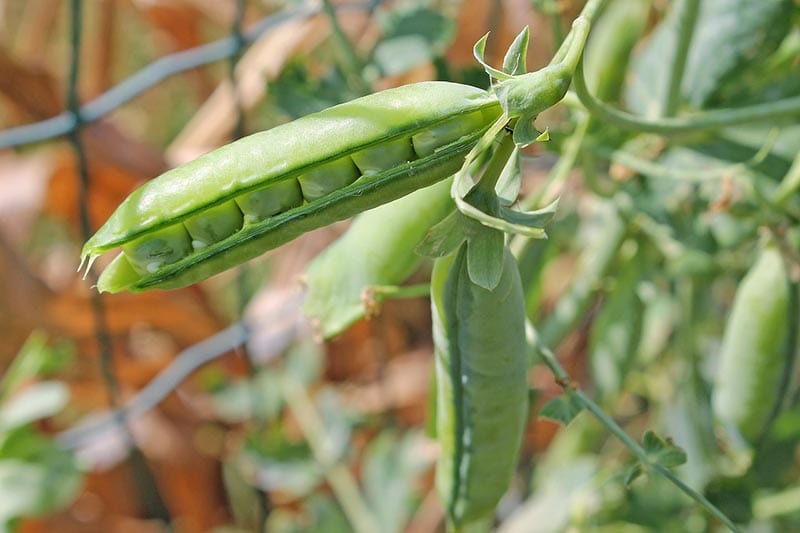
Legumes are a great (and 100% natural) source of nitrogen that cucumbers need to grow. Their root system is quite advanced and capable of making the most of the soil. So, if you were planning on sowing some beans or peas but couldn’t pick the right spot, planting them right next to cucumbers will be a wise move. Lentils are another great companion option.
On average, it takes 50–60 days for legumes to grow. That means you won’t have to wait for long before they enrich the soil and boost the cucumber harvest. Pole beans aren’t recommended here, though; instead, go with bush beans. Also, see that the cucumbers are 2–3 inches tall before you plant the peas or beans.
2. Corn Crops
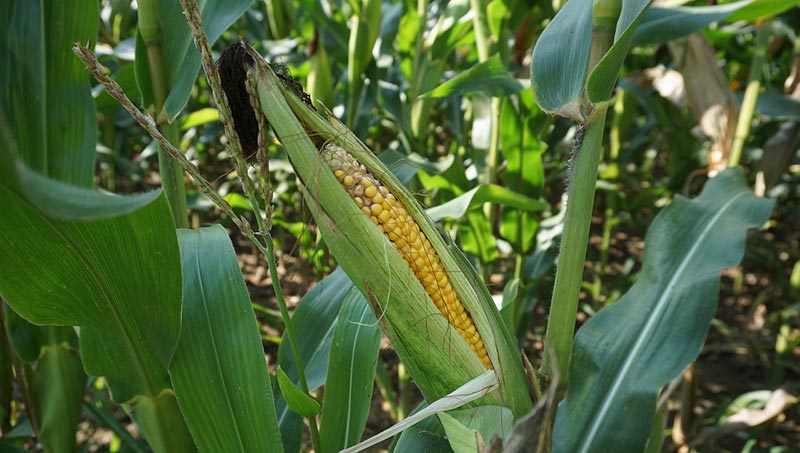
Worried a bit that the cukes won’t get any support while growing? Well, why not use corn as an improvised trellis? On top of helping the vines climb up, corn will shade them from the sun. This is especially important when the cucumber crops are still tiny and might not handle full exposure to sunlight. That’s not it for the pros yet! Just like peas and beans, corn is praised for adding nitrogen to the soil.
3. Carrots and Radishes

There’s a common misconception that cucumbers and root vegetables are a bad pair since they’ll all be fighting for the soil, but that’s not true. Cucumber roots are mostly thin, shallow, and reach 10-12 inches in any direction. They only have one single taproot—it won’t cause any trouble for carrots, radishes, and other veggies that prefer to grow deep into the soil.
But still, why would you want to pick them for companion planting? Radishes are a strong solution against squash bugs. Second, this way, you’ll be able to make the most out of the space that you have in the garden. Radishes and carrots sprout quickly, too, and will be ripe for harvest before the cukes grow tall. So, it’s a win-win!
4. Parsnips and Beets

If you’re not a big fan of carrots and radishes but still want to have root vegetables with cucumbers, beets and parsnips will be a great pick. You’ll get the same deal with these vegetables, meaning no encroaching on the cucumber territory, rapid growth, and bug-repelling capabilities.
5. Onions
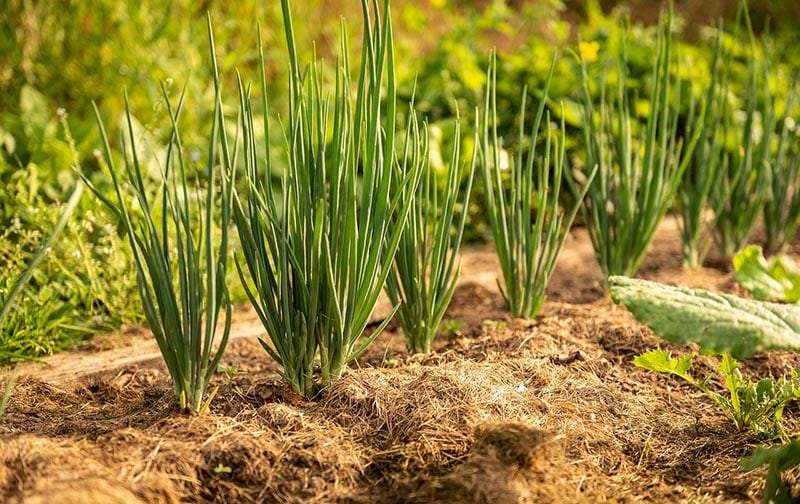
And what about onions—why pick them over carrots, parsnips, and beets? Onions are better at repelling bugs than radishes. They are rich in sulfur, making bugs turn away before reaching the crops. The same is true for garlic and pepper, by the way. If the pest infestation is large, try mixing these vegetables with water and using a spray bottle to treat cucumber leaves.
Flowers
While flowers aren’t the first thing that pops into one’s head when asked about companions for cucumbers, they can, indeed, be a great match. The following list includes species based on their ability to serve as a repellent against the “bad” bugs and attract the “good” bugs while causing no harm to cukes. Check them out:
6. Sunflowers
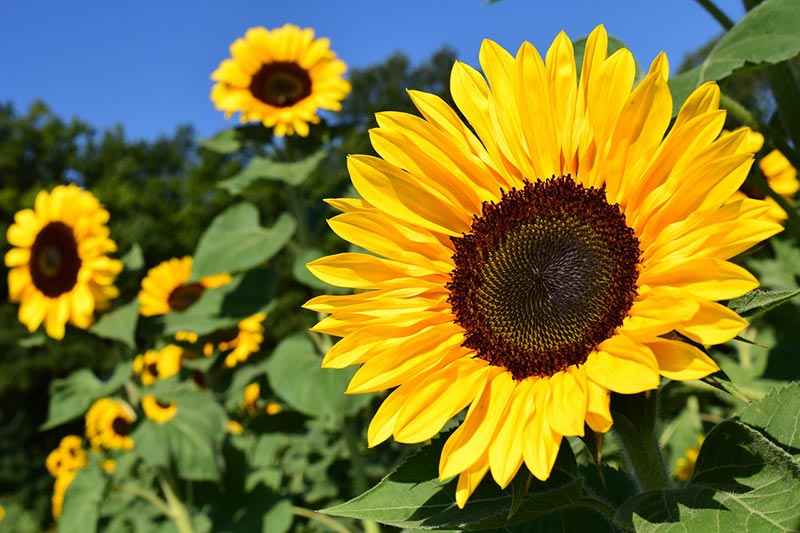
Don’t have the time or the budget for a full-fledged trellis? If you plant your cucumbers alongside a pack of sunflowers, you won’t even need one! Much like corn, sunflowers grow fast and tall, which makes them a perfect framework for a vining vegetable species. Not only will you save money on buying a lattice from a store but also boost your garden’s efficiency.
Another big pro: these natural trellises will protect the plants from the scorching sun. The key here is to plant the correct cucumber variety, like maybe the pickling cucumbers. If the crops are too big and heavy, the sunflower stalks simply won’t be strong enough to support them.
7. Marigolds
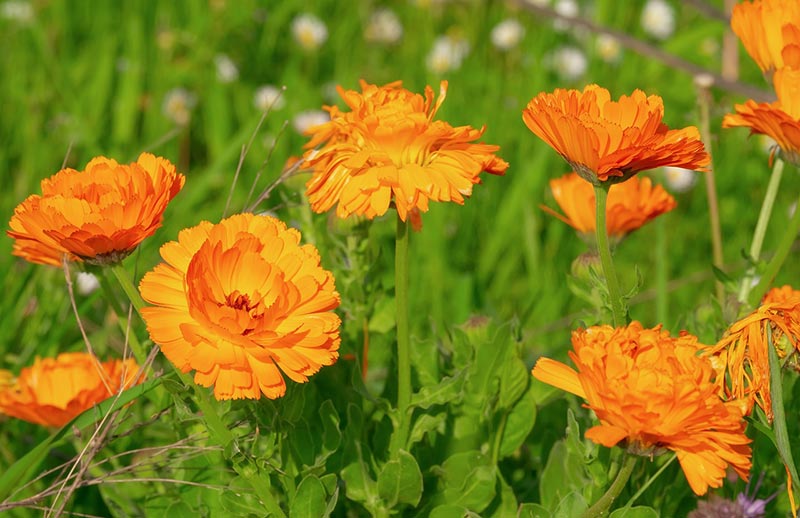
Beetles, aphids, mealybugs, and thrips like to feed on cucumber leaves and crops. And while you can, of course, kill them with a repellant (both synthetic and natural), planting a couple of marigolds next to the cukes will help solve the problem. A recent study has shown that these flowers release limonene into the atmosphere, and that’s what scares destructive bugs away.
The fact that marigolds are also very beautiful makes them an even better pick as a companion plant.
8. Nasturtium
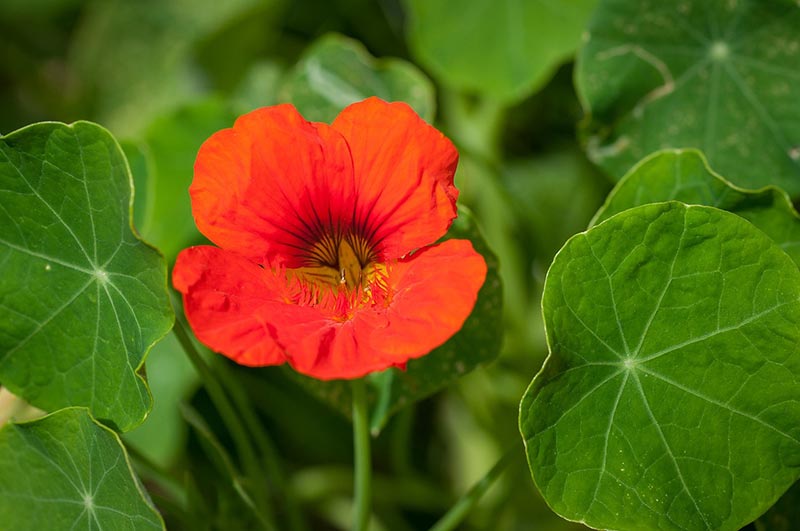
Just like marigolds, nasturtiums are instrumental in scaring pests away. While there are approximately 80 species in this genus, you won’t have to do any picking, as all the species are equally strong as insect repellants. They’ve proven to be effective against squash bugs, whiteflies, and beetles, to name a few.
What you probably don’t know is that these flowers are known to attract aphids and black flies. That’s good news, though: you can use them as trap plants. Instead of planting nasturtiums alongside cucumbers, put a short distance between these two plants and witness all the insects in the area lean towards the nasturtiums instead of the cucumber crops!
Herbs
If you already have a lovely pack of herbs growing in the garden, chances are, some of those plants are a match made in heavens for cucumbers. While the list of compatible herbs isn’t very big, it’s still important to know which species go well with cucumbers. Here they are:
9. Oregano

The biggest pro of using oregano as a companion plant for cucumbers has to do with its low-spreading nature. Give it some time to grow, and this herb will do a great job of safeguarding the soil from the sun. And, since cucumbers do prefer the soil to be a bit cooler than average, this combo will be beneficial.
However, that doesn’t mean you can use oregano with every single vegetable, fruit, or flower out there. It all comes down to the temperature preferences of various plants and how strong or weak they are against the sun. Going back to oregano, it will protect your crops from pests: it contains oil (used to treat various health conditions) that most bugs hate.
10. Dill

In many ways, dill is the same as oregano—or, at the very least, it has similar properties. You can rely on it to shield vulnerable cucumber leaves from pests. In addition, dill will attract beneficial bugs, including syrphid flies, lacewings, ladybugs, and parasitic wasps that feed on pests. It has a lovely aroma that draws pollinators in as well—that will have an even bigger impact on the well-being of your plot.
As a bonus, the cucumbers will grow bigger and taste better (that hasn’t been scientifically proven yet, though). Now, dill isn’t pretty per se, but it is quite beneficial for our health. It can reduce cholesterol levels and the risk of strokes and heart diseases. Dill is also rich in Vitamins A and C, iron, and calcium.
11. Chives

Often mistaken with green onions, chives are much more delicate yet have a very strong smell. As you can imagine, that makes them a go-to pick as a companion plant for cucumbers. While chives won’t keep every single pest in your garden away, when planted right next to cucumbers, they will be able to protect the leaves, flowers, and fruits. This is a beautiful herb, too, with pink blooms and tubular, blue-green leaves.
12. Borage
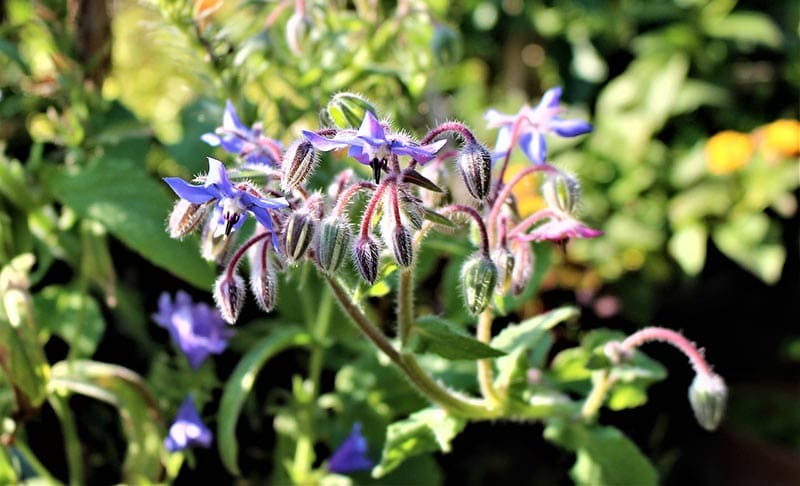
If you’re having a hard time persuading natural pollinators to “work” on your cucumber crops, try to plant some borage flowers in the garden. Native to the Mediterranean, the starflowers are incredibly beautiful and have a nice smell. Many gardeners plant them solely for aesthetic reasons.
But, the borage flower can also attract ladybugs and bees that feed on its blooms. This is a self-seeding plant that adds nutrients to the soil. The one thing to keep in mind is that borage likes to spread. So, give it some “personal space”, and it will flourish. And one more thing: its flowers taste like cucumbers—funny, right?
13. Calendula
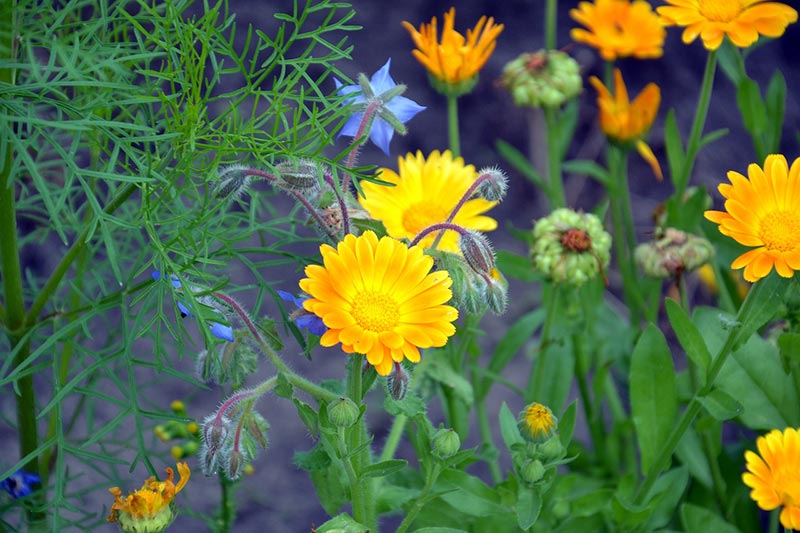
Have you ever seen a field of calendulas? It’s a sight for sore eyes! The orange heads make them stand out and attract pollinators and beneficial insects. And, much like nasturtiums, calendulas (also called the Pot Marigolds) are excellent trap plants for many pests that turn into prey for wasps, hoverflies, and other cucumbers. Last, but not least, these herbs are often used to treat muscle fatigue, heart conditions, and inflammation.
Worst Companion Plants for a Cucumber
Alright, now that we know which plants go well with cucumbers, here’s a quick look at the worst companions that you should keep as far from cukes as possible:
- Hungry for nutrients, potatoes will always try to steal elements from the soil and the water that you intend for the cucumbers. That’s precisely why potatoes are categorized as one of the worst plants to grow alongside cucumbers. Eggplants and tomatoes aren’t nearly as bad, though.
- Did you know that these vining plants serve as a magnet for insects? That’s right, and the pests will mainly feed on the precious cucumber crops and roots. So, make sure to plant them at least 2–3 rows apart. Otherwise, you might end up losing your cukes!
- To clarify: pumpkins aren’t at all intrusive. However, pests do like to feast on pumpkins (or any other squash, for that matter), which makes them just as dangerous as melons. The farther apart you plant pumpkins from cucumbers, the better.
- Cabbage and cauliflower. These plants need large amounts of water to survive, especially in a hot and dry climate. When planted next to cucumbers, they will consume most of the water. This is true for the vast majority of plants in the brassica family, by the way (like kale, kohlrabi, and Brussels cabbage).
- Although it belongs to the carrot family, fennel is not recommended to use as a companion plant for cucumbers, as it will slow their growth. In the worst-case scenario, fennel may even end up killing your cucumber crops (depending on how many you plant).
- No, sage doesn’t rob nearby plants of vital elements or attract bugs. It does, however, slow down the growth of many vegetables, including cucumbers. Furthermore, since it has a very strong aroma, it often affects the flavor of the cukes, which is not something that you want.
- This perennial herb is quite aggressive and doesn’t shy away from grabbing all the nutrients for itself. On top of that, mint is known to “trespass”, encroaching on the space intended for the cucumbers. When left untreated, it might just banish cucumbers from their own land.
Conclusion
Cucumbers don’t need you to “babysit” them to prosper. However, they can always benefit from companion planting, as long as you pick the correct plants for that. Lucky for us, avid gardeners, there are quite a few options out there that match cucumbers perfectly. With these plants, you’ll get to increase their productivity, keep pests away, and ensure proper pollination.
Not every single vegetable out there gets along with cucumbers, though. Some species might end up hurting the crops instead of helping with their growth. So, before you sow any seeds, use our comprehensive list of the best/worst companion plants as a guide. If you do this right, the results can be truly amazing!
- National Pesticide Information Center – Beneficial Insects
- GrowingGuides – The History Of Companion Planting
- MasterClass – 7 Cucumber Companion Plants
- Homes&Gardens – Cucumber companion planting
- Edu – Trap Cropping for Small-Market Vegetable Growers
- PlosOne – Companion planting with French marigolds
- SustainableFoodCenter – Dill for You and Your Butterflies
- BeeTheChange – Natural Alternatives to Pesticides
- MD – Health Benefits of Dill
- Calendula Tea: Are There Health Benefits?
- NMState – Nitrogen Fixation by Legumes
- UNL – Effects of Radishes on Squash Bugs
Featured Image Credit: Alexei_other, Pixabay
Contents


